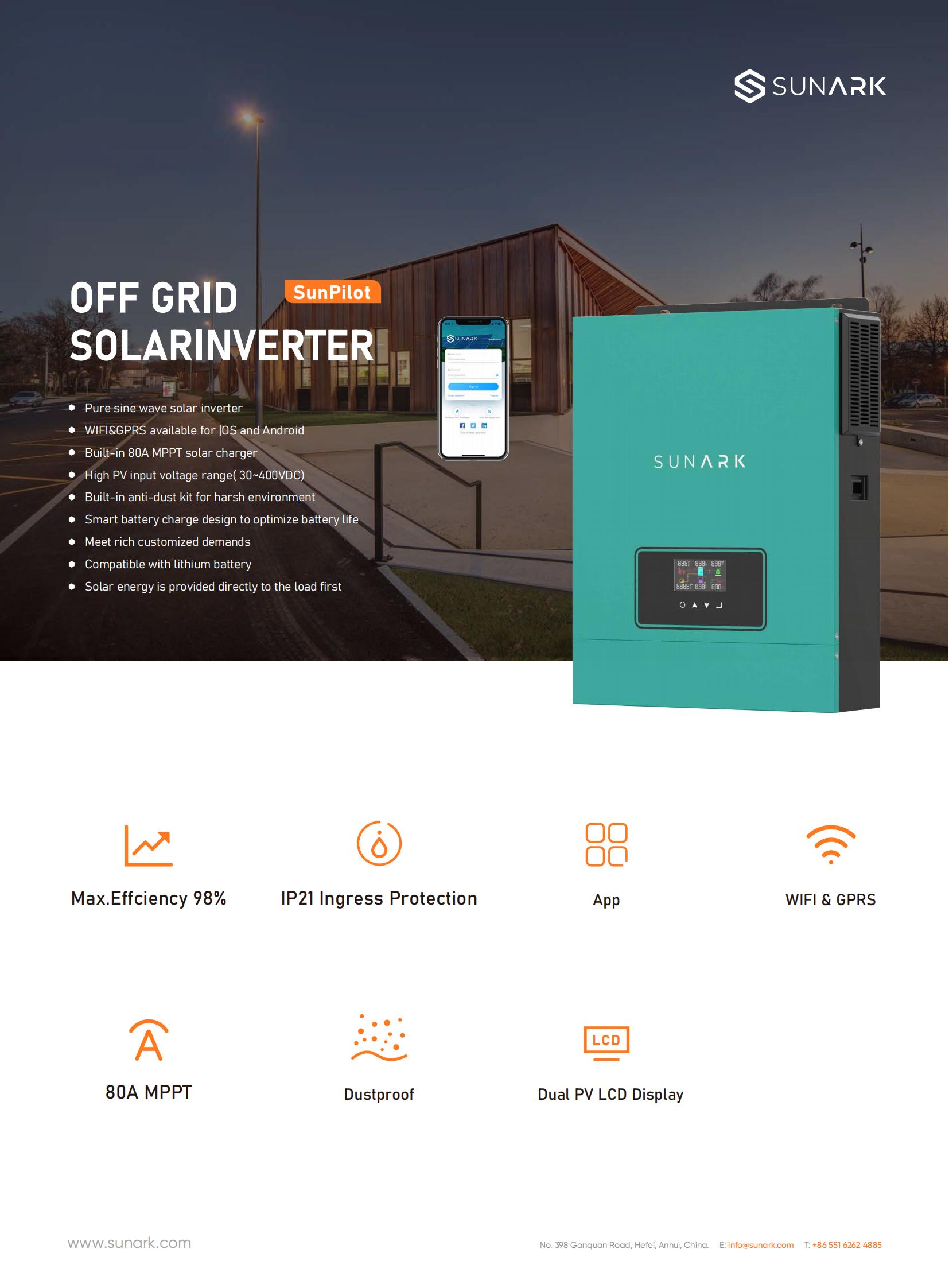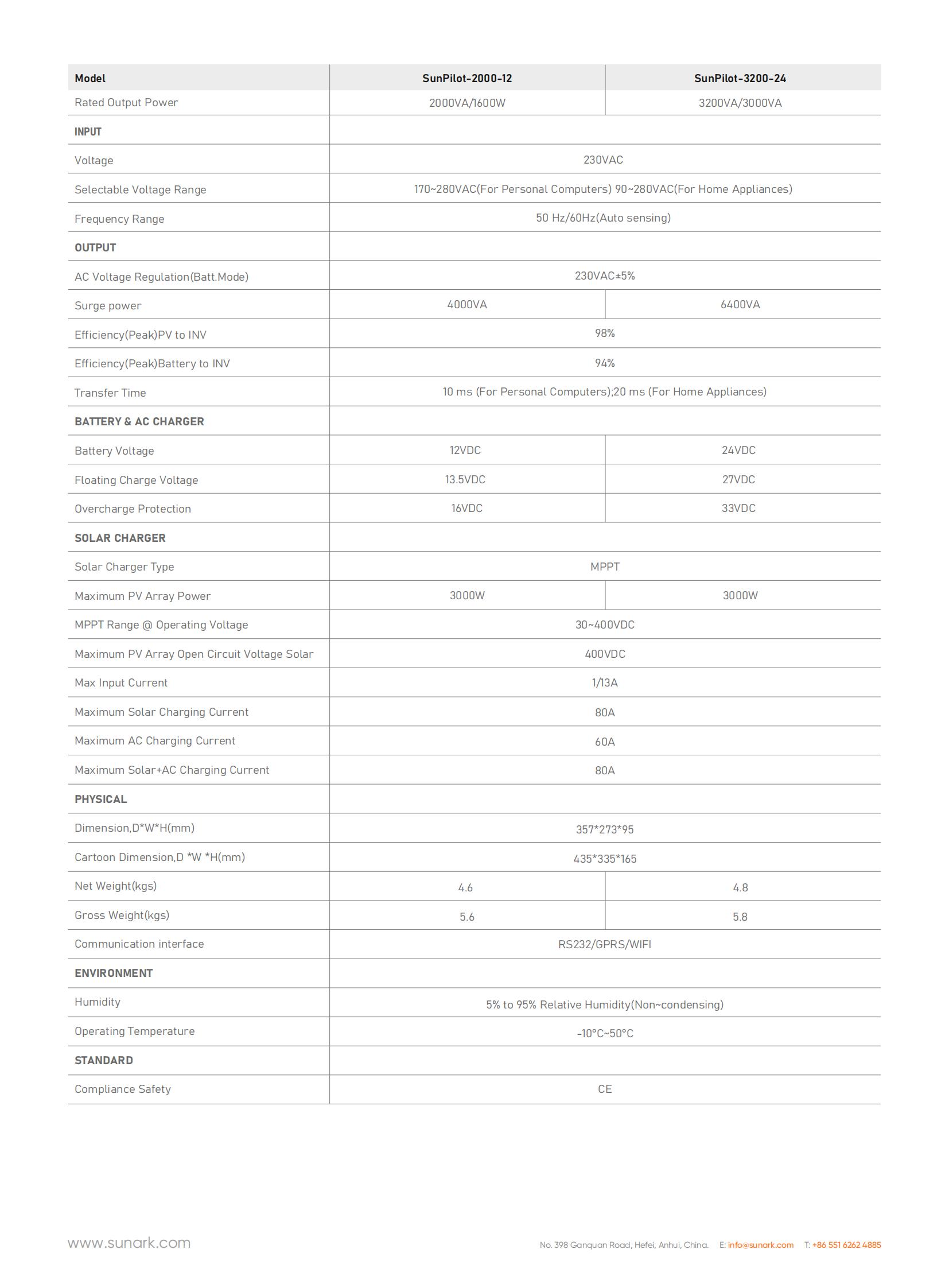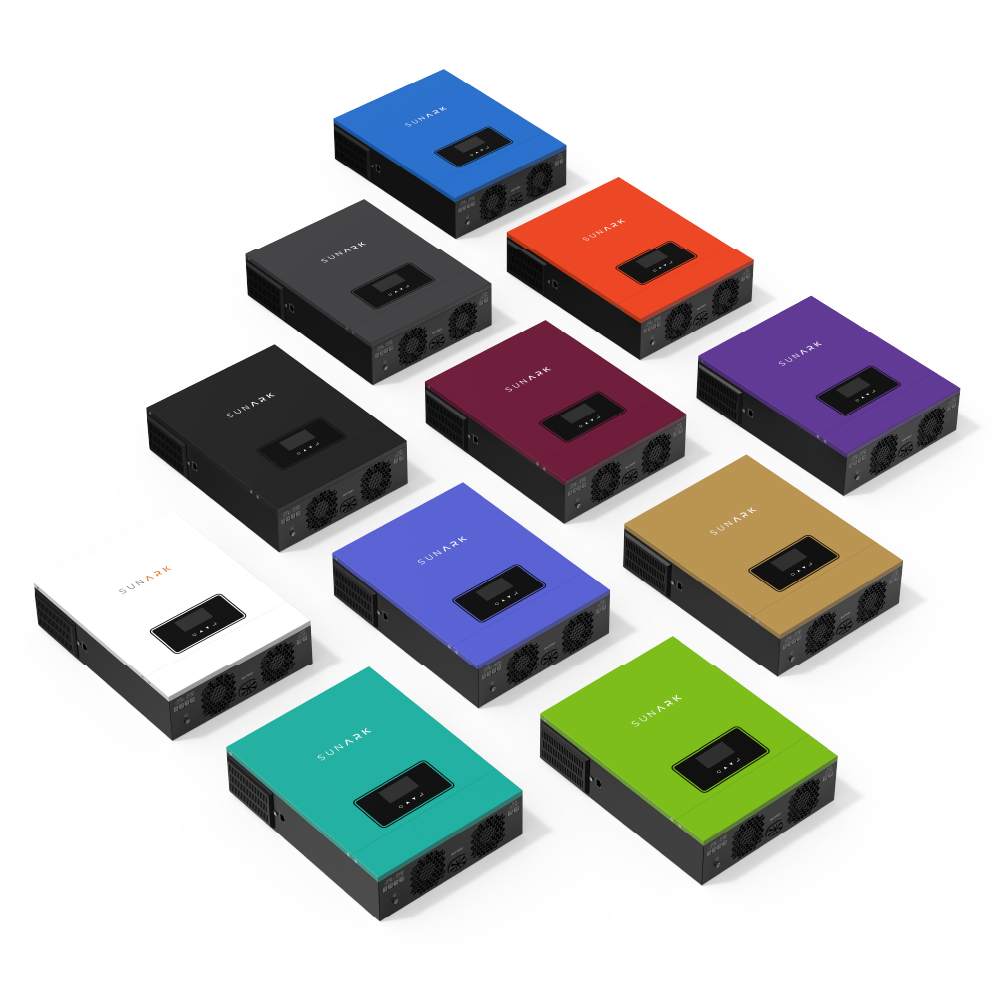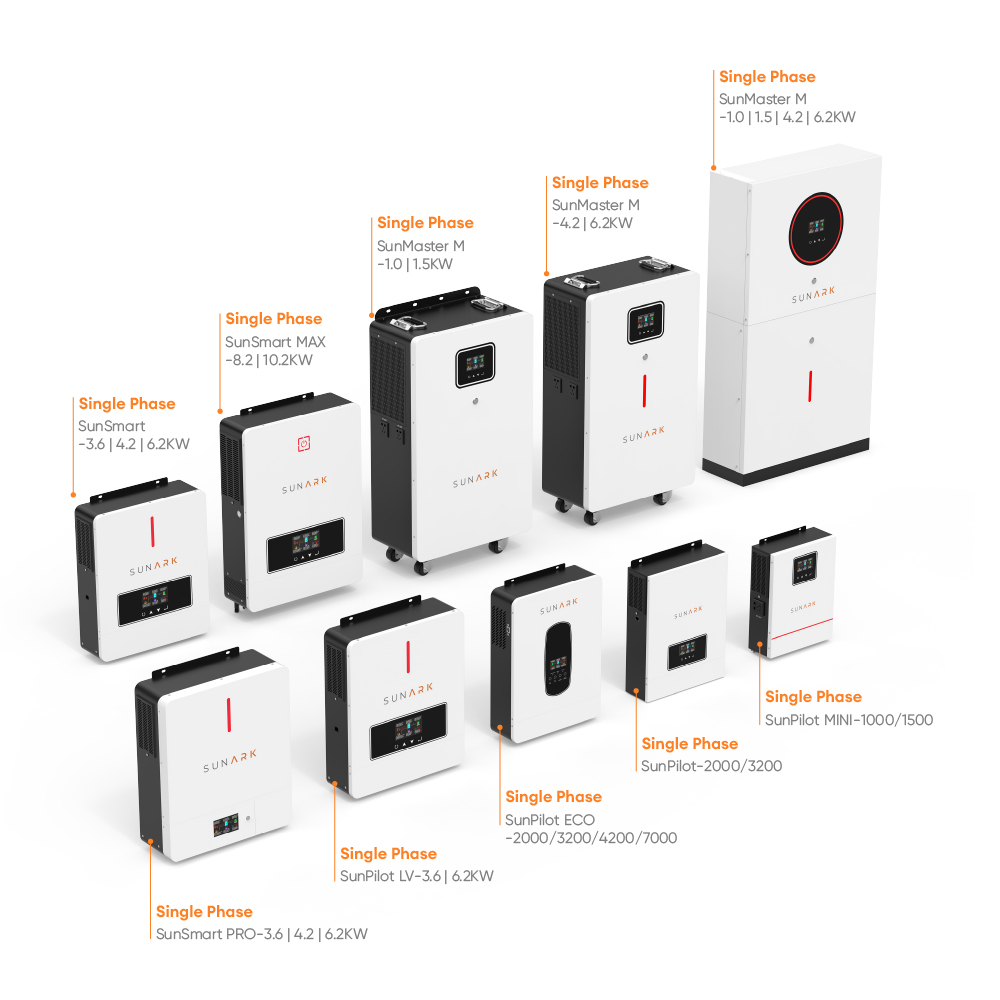อินเวอร์เตอร์พลังงานแสงอาทิตย์แบบไฮบริดรวมความสามารถของอินเวอร์เตอร์ที่ผูกกับกริด เครื่องชาร์จแบตเตอรี่ และอินเวอร์เตอร์นอกกริดไว้ในอุปกรณ์เดียว ช่วยให้การทำงานระหว่างพลังงานแสงอาทิตย์ การจัดเก็บแบตเตอรี่ และโครงข่ายไฟฟ้าเป็นไปอย่างราบรื่น ช่วยให้สามารถควบคุมได้มากขึ้น ความเป็นอิสระด้านพลังงาน และความสามารถด้านพลังงานสำรองในระบบสุริยะ
ยี่ห้อ:
SunArk:
SunArk SunPilot-3200-24 3000W 30~400VDC 3200VA 230VAC±5%เอกสารข้อมูลของ SunArk SunPilot series 3200VA ด้านล่าง:


สีที่ต่างกันสำหรับตัวเลือก:

อินเวอร์เตอร์พลังงานแสงอาทิตย์แบบไฮบริดทำงานโดยการจัดการการไหลของไฟฟ้าในระบบพลังงานแสงอาทิตย์ โดยผสมผสานโหมดการทำงานหลายรูปแบบเพื่อเพิ่มประสิทธิภาพการใช้พลังงาน ต่อไปนี้เป็นคำอธิบายทั่วไปเกี่ยวกับวิธีการทำงานของอินเวอร์เตอร์พลังงานแสงอาทิตย์แบบไฮบริด:
โหมดพลังงานแสงอาทิตย์:
เมื่อแสงอาทิตย์ตกกระทบแผงโซลาร์เซลล์ มันจะแปลงพลังงานแสงอาทิตย์เป็นไฟฟ้ากระแสตรง จากนั้นไฟฟ้ากระแสตรงจะถูกส่งไปยังอินเวอร์เตอร์พลังงานแสงอาทิตย์แบบไฮบริด
โหมดผูกตาราง:
ในโหมดผูกกริด อินเวอร์เตอร์พลังงานแสงอาทิตย์แบบไฮบริดจะซิงโครไนซ์เอาต์พุตกับกริดสาธารณูปโภค โดยจะแปลงไฟฟ้ากระแสตรงจากแผงโซลาร์เซลล์เป็นไฟฟ้ากระแสสลับ ซึ่งเข้ากันได้กับแรงดันไฟฟ้าและความถี่ของกริด อินเวอร์เตอร์จะจ่ายไฟ AC นี้เข้าสู่บ้านหรือธุรกิจของคุณโดยตรงเพื่อจ่ายไฟให้กับเครื่องใช้ไฟฟ้าของคุณ ไฟฟ้าส่วนเกินใดๆ ที่เกิดขึ้นจะถูกป้อนกลับเข้าสู่โครงข่าย และในบางกรณีจะจ่ายเข้าบัญชีของคุณผ่านแผนการวัดแสงสุทธิ
โหมดการชาร์จแบตเตอรี่:
หากอินเวอร์เตอร์พลังงานแสงอาทิตย์แบบไฮบริดเชื่อมต่อกับแบตเตอรี จะสามารถใช้ไฟฟ้าพลังงานแสงอาทิตย์ส่วนเกินเพื่อชาร์จแบตเตอรี่ได้ เมื่อแผงโซลาร์เซลล์ผลิตไฟฟ้าได้มากกว่าที่บ้านของคุณใช้หรือป้อนกลับเข้าไปในโครงข่าย พลังงานส่วนเกินจะถูกโอนไปเพื่อชาร์จแบตเตอรี่ อินเวอร์เตอร์จะควบคุมกระบวนการชาร์จเพื่อเติมแบตเตอรี่อย่างมีประสิทธิภาพตามความจุที่แนะนำ
โหมดนอกตาราง:
หากไฟฟ้าขัดข้องหรือคุณจงใจตัดการเชื่อมต่อจากกริด อินเวอร์เตอร์พลังงานแสงอาทิตย์แบบไฮบริดสามารถทำงานในโหมดนอกกริดได้ ในโหมดนี้ มันจะดึงไฟฟ้ากระแสตรงจากแผงโซลาร์เซลล์แล้วแปลงเป็นไฟฟ้ากระแสสลับเพื่อจ่ายไฟให้เครื่องใช้ไฟฟ้าของคุณโดยไม่ขึ้นอยู่กับโครงข่ายไฟฟ้า อินเวอร์เตอร์ใช้พลังงานที่เก็บไว้ในแบตเตอรี่เพื่อตอบสนองความต้องการทางไฟฟ้าในช่วงที่มีพลังงานแสงอาทิตย์ไม่เพียงพอ แบตเตอรีแบงค์ทำหน้าที่เป็นแหล่งจ่ายไฟสำรอง โดยจ่ายไฟฟ้าในช่วงวันที่มีเมฆมากหรือตอนกลางคืน
โหมดไฮบริด:
ในโหมดไฮบริด อินเวอร์เตอร์พลังงานแสงอาทิตย์แบบไฮบริดจะรวมพลังงานจากทั้งแผงโซลาร์เซลล์และโครงข่ายไฟฟ้า โดยจะจัดการการไหลของไฟฟ้าอย่างชาญฉลาด โดยจัดลำดับความสำคัญของการใช้พลังงานแสงอาทิตย์มากกว่าพลังงานโครงข่าย เพื่อลดความพึ่งพาโครงข่ายและลดต้นทุนด้านพลังงาน อินเวอร์เตอร์จะตรวจสอบการสร้างพลังงานแสงอาทิตย์ สถานะการชาร์จของแบตเตอรี่ และสภาวะของกริดอย่างต่อเนื่อง เพื่อปรับประสิทธิภาพของระบบให้เหมาะสมที่สุดและเพิ่มการบริโภคเองให้สูงสุด
การจัดการพลังงาน:
Hybrid solar inverters often have advanced energy management features. They can implement load shifting, which means scheduling the operation of specific appliances to take advantage of available solar power. For example, the inverter can automatically power high-consumption appliances like washing machines or water heaters during peak solar production times. This helps to reduce reliance on the grid and maximize self-consumption.

The key components and operations of a hybrid inverter in a solar system are as follows:
Solar panel connection: The hybrid inverter is connected to the solar panels on your roof or at a suitable location to capture sunlight. The solar panels convert sunlight into DC (Direct Current) electricity.
MPPT (Maximum Power Point Tracking): The hybrid inverter typically includes a Maximum Power Point Tracker, which optimizes the electricity output from the solar panels by adjusting the voltage and current to maximize power production.
Grid interaction: The hybrid inverter allows you to feed the excess electricity generated by the solar panels back into the grid. This process is known as "grid-tied" or "net metering." When your solar panels produce more electricity than you are consuming, the excess power is sent back to the grid, and you receive credits or compensation from the utility company.
Battery connection: Hybrid inverters have the capability to connect to a battery bank or energy storage system. During times when your solar panels are not generating enough electricity to meet your demand, the hybrid inverter can draw power from the batteries to supplement the shortfall.
Battery charging: When the solar panels produce more electricity than immediate demand, the excess power can be used to charge the batteries. The hybrid inverter manages the charging process to ensure the batteries are charged efficiently and not overcharged.
Backup power supply: In the event of a power outage or when the grid is not available, a hybrid inverter with batteries can automatically switch to "off-grid" mode, supplying power from the battery bank to essential loads in your home or business. This feature provides backup power during emergencies.
Monitoring and control: Hybrid inverters often come with monitoring and control capabilities. You can monitor the performance, energy production, battery status, and other parameters remotely using monitoring software or mobile applications. Some hybrid inverters also allow you to control charging and discharging of batteries or customize operation settings.
สิ่งสำคัญคือต้องทราบว่าคุณลักษณะและฟังก์ชันเฉพาะของอินเวอร์เตอร์ไฮบริดอาจแตกต่างกันไปตามผู้ผลิตและรุ่นต่างๆ เมื่อพิจารณาอินเวอร์เตอร์ไฮบริดสำหรับระบบพลังงานแสงอาทิตย์ของคุณ ขอแนะนำให้ปรึกษากับผู้ติดตั้งมืออาชีพเพื่อให้มั่นใจถึงความเข้ากันได้และการออกแบบระบบที่เหมาะสมที่สุด